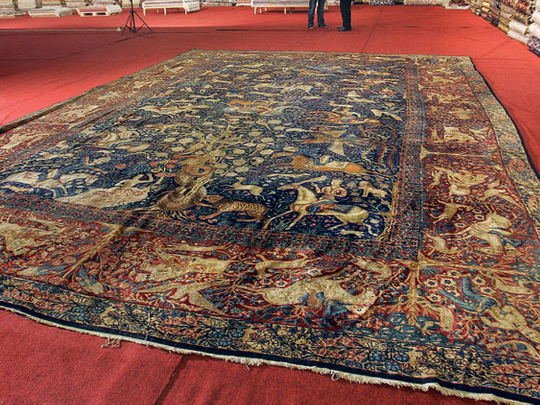
Dubai : To the untrained eye, the ageing blue carpet rolled out on the floor of the Dubai Airport Expo hall looks like any antique floor-covering that's seen better days.
But in the eyes of international carpet expert Amir Ghanbarinia, the sprawling 7.5mx5.5m-piece of Iranian antiquity is nothing short of a Dh12 million (over $3.2 million) magic carpet.
At XPRESS's behest, the managing director of Heritage Carpet in Dubai instructed his staff to unravel the imposing Persian carpet, a rare art treasure that has been graced by the feet of kings, princesses and US presidents.
Delicate work
"This carpet has known greatness for many years. It's a royal carpet and is part of my private collection. It's not for sale," said Ghanbarinia, pointing to anthropomorphic, human and animal figures delicately woven into the wool-and-silk tapestry that's being displayed as part of Dubai Shopping Festival's Carpet Oasis exhibition.
Ghanbarinia said the carpet was commissioned in 1885 by Persian King Nasser-Al-Din Shah of the Qajar dynasty for his royal palace. The iconic characters of the design, he said, are based upon the Kalila Wa Demna, a Persian best-selling collection of fables adapted from India's literary favourite — the Panchatantra.
"King Nasser-Al-Din decided to make a carpet featuring the stories in the book and put it in his palace," he said. "It probably took weavers eight to 10 years to finish this carpet." Central in the theme, he said, is a tall dragon eating gracious white birds.
A powerful lion is shown gnawing at the tail of the dragon.
According to Ghanbarinia, the symbolic translation of the theme illustrates birds as innocents being eaten by the dragon, which represents the intellectuals of that time who, in turn, may succumb to the power and authority of the lion or Iran's king.
Ironically, more than a century later, Ghanbarinia has privately shown the carpet to modern-day leaders such as former American presidents Bill Clinton and George W. Bush, who are among a worldwide list of his clients, he said. The carpet also depicts horses and an elephant — evidence that Armenian and Indian designers of that era were consulted to shape it before work on the wooden loom commenced.
Expensive rugs
High quality genuine Persian carpets are very expensive and sought after, especially due to the sharp decline in the number of artisan weavers across Iran who earn as little as Dh15 per day for their skills, he said. "Fewer people are now doing this job, that's why carpet prices in the last five years have tripled," he added.
Latest numbers, he said, show that once there were 10 million weavers, a skilled workforce that has dropped to slightly more than five million.
The Carpet Oasis show runs until February 28.











